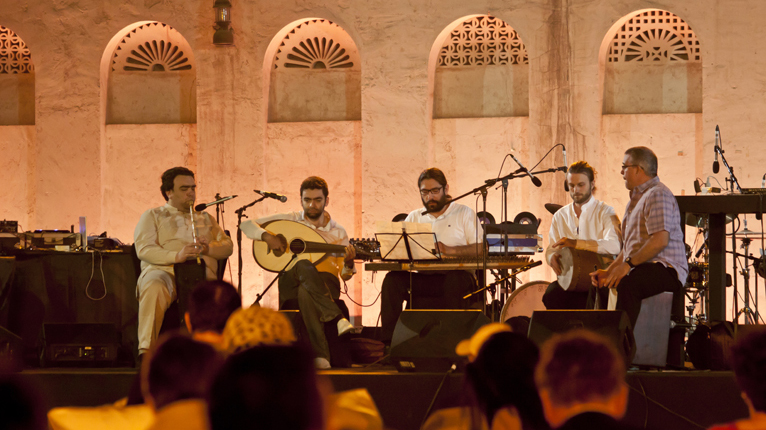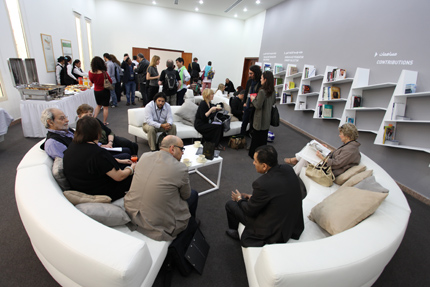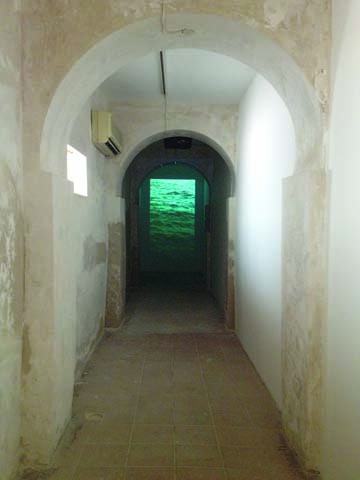SHARJAH NEWS
| June 25, 2012 | Post In LEAP 15

ALTHOUGH EVERYTHING IN the Middle East may be big news at the moment, it remained necessary to explain to everyone, on the eve of a visit to Sharjah, exactly what Sharjah is. The vast majority of my Beijing friends— both foreign and Chinese— reacted the same way to hearing these two syllables: they were completely unsure whether Sharjah was the name of a place that actually existed. The few who pay attention to international politics surmised that I was talking about Gaza in Palestine. When I explained that Sharjah is in fact one of the seven members of the United Arab Emirates, some said: “Oh, Saudi Arabia?” This confusion reveals to us not only a blind-spot on our horizons, but also a manifestation of our own narrowness and narcissism. So before disembarking for Sharjah, it was not enough to say that we were visiting someplace where we had to start from zero; rather, it is more appropriate to consider this trip a surgical reconstruction of our self-knowledge.
I was in Sharjah for the emirate’s “March Meeting,” an annual gathering of the Middle East’s art world which also provides a platform for dialogue and exchange with colleagues from around the world. The event is hosted by the Sharjah Art Foundation and has become a major event on the Arab world’s art calendar. Each year, it takes place around the same time as Art Dubai, and in odd-numbered years, it coincides with the Sharjah Biennial, drawing on and contributing to the seasonal flurry of activity in regional art circles.
Like the other emirates, Sharjah benefits from oil wealth and other geographical advantages of the gulf region. But unlike Dubai’s flourishing center of art commerce, and Abu Dhabi’s burgeoning museum hotspot, Sharjah is home to a more scholarly contemporary art scene comprising three primary components: the biennial, which has already been held ten times; the “March Meeting,” a platform for art-world professionals now in its fifth year; and a strong exhibition and performance scene held in museums or amid cultural relics. Sharjah Art Foundation President Sheikha Hoor Al-Qasimi believes that the arts in Sharjah are a product of organic growth, as opposed to being conjured from thin air. The strategy of Sharjah Art Foundation doesn’t rely on having its own building, but on intervening in the public space, organizing exhibitions where most appropriate.

\
The theme of this year’s event is fairly concrete: “Working with Artists and Audiences on Commissions and Residencies.” The Foundation— which is funded by the emir of Sharjah Sheikh Sultan bin Mohammed Al-Qasimi and also hosts the biennial— has for years also engaged in commissioning artworks and providing residencies for artists. Due to the uproar caused by one controversial piece commissioned for last year’s biennial, this year’s theme implies there was a rethinking of the commissioning and residency system on conceptual, operational, and policy levels. The result— the preservation of the existing system— is evident in the hard work done by the event’s organizers. Moreover, the appointment of Yuko Hasegawa as curator of next year’s biennial also clearly demonstrates that Sharjah remains ambitiously motivated to be a regional hub of the contemporary art landscape today and in the future.
Through three days of lectures, demonstrations, and discussions, some 80 organizations and individuals shared their work and experience, while downtime provided opportunities for banter and informal networking. The attendees included big-name curators and directors of major European and American institutions in addition to the local and international individuals and organizations. At one private gathering, I heard the young Istanbul artist Didem Ozbek— who operates her own space, PiST— recount her various policy and funding challenges to James Lingwood of the United Kingdom’s venerable Artangel gallery. Naturally, it was difficult to infer any apprehension in Lingwood’s poised response. Artangel receives nearly 50% of its funding from government coffers, and rarely faces difficulties in obtaining visas for artists, but Artangel must also deal with ambitious young artists and their failure to observe deadlines or budgetary restrictions, and even the occasional “accidents” leading to major last-minute exhibition overhauls. Nor is Artangel immune to the funding threats posed by political and economic change. Throughout the event, I could not determine with certainty whether the established name-brand institutions and the alternative art spaces were genuinely benefiting from sharing their practical experiences. After all, their methods, environments, and obstacles were difficult to compare. But the exchange in and of itself was evidently breaking down barriers, and the establishment of new connections has become an essential facet of today’s global art world.
As a platform for sharing, the “March Meeting” allowed its participants to learn what is going on around the world. Lectures given by two Chinese participants drew a great deal of curiosity in the audience. Vitamin Creative Space’s Hu Fang drew a connection between the writing of fiction and the operation of alternative art spaces, dwelling on the fruits of “extra-systemic” creativity. Lu Jie used the terminology of commissions and residencies to discuss the “walking” experience of the Long March Project, but he seemed to denounce the systemization of commissions and residencies for leading to clichéd art.

In addition to the conference, a few concurrent exhibitions and performances added yet more charm to Sharjah’s spring art scene. “What Should I Do to Live in Your Life” reflected curator Claudia Pestana’s ruminations upon relocating to Sharjah and coming face-to-face with the emirate’s long cultural history and unique artistic ecology. The artists in the exhibition (Lee Kit, Minouk Lim, João Vasco Paiva, Part-time Suite, and Yuk King Tan) were all strangers to Sharjah as well. Their images, videos and installations were dispersed throughout the rooms of an ancient Arab mansion, obliging visitors to enter spaces previously reserved for the private lives of locals in order to view contemporary art created by outsiders.
The most widely discussed event was a concert held in Arabic Calligraphy Square. Lebanese sound artist Tarek Atoui brought together avant-garde sound artists and traditional Arabic musicians to perform Revisiting Tarab. Sitting on an Arabian carpet and listening to a New York sound artist of Japanese descent use a notebook computer to improvise with a local player of traditional drum music, one could not help but marvel at the virtues of cultural exchange. And the story behind the performance—which was commissioned and produced by the Sharjah Art Foundation— provided a sterling example of the type of artwork that was discussed at this year’s “March Meeting.” (Translated by Daniel Nieh)


